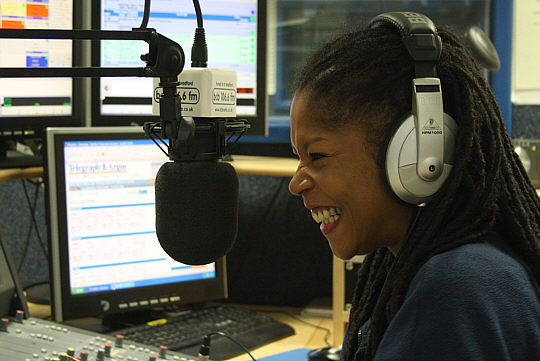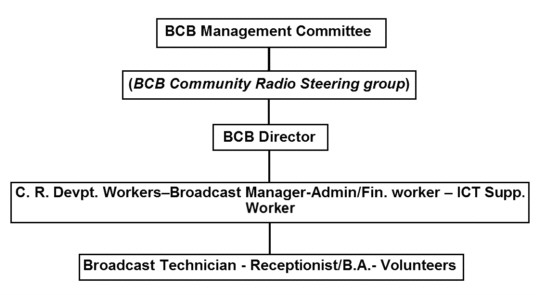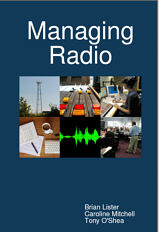A case study by Caroline Mitchell

Introduction
Bradford Community Broadcasting (BCB) is an example of good practice in UK community radio. Bradford is a large, culturally diverse city of around 280,000 residents that made its former wealth through the textiles industry. BCB broadcasts to a five kilometre radius from Bradford city centre and although it was finally awarded a community licence to broadcast from January 2006 it has broadcast full-time since 2002 under the Access Radio pilot scheme and between 1992 and 2002 using around 30 different RSL licences on both AM and FM. The station received the Radio Academy Nations and Regions Award for the North East and Yorkshire region in December 2003. Since 1992 the station has grown from a RSL run on volunteer effort to a thriving station with nine paid staff and at least 200 volunteers. It has state of the art studios and offices in the centre of Bradford and these city centre premises are linked with ISDN lines to outreach studios in the suburbs of Whetley Hill and Shipley. This ''hub and spoke' policy brings broadcasting facilities as close to local communities as possible' (Everitt 2003: 39). The station can be received on FM and podcasts and puts programmes and features on its website for download. It can also be received through mobile phones! (Via 3g iphone or smartphone)The core of BCB's philosophy of community radio is to enable all parts of the community to make programmes and to get involved in every aspect of running a radio station: in effect the community become managers. How this has taken place successfully is for the most part down to the inspirational leadership and inclusive management style of Mary Dowson, Chief Executive (CEO) and general manager of BCB. Coming from a community education and development background herself she has worked to instil the essence of participatory philosophy, managing volunteers and staff –most of the staff have already been volunteers on the station.
Developing the audience
BCB aims 'to serve the diverse inner city communities of the Bradford District, including a wide range of black and minority ethnic communities, diverse age groups, geographic communities and specialist interest groups.'As discussed in Section 2.1, audience research for community radio is as much to do with what listeners want to hear as with the interests of the community broadcasters who make each programme. Like most community stations the station does not take part in Rajar surveys but estimates that it has around 30,000 listeners (Edmonds and Buckley 2005: 13). The assumption is that audience research relating to programme content is done by programme makers themselves as the programme content comes from, and relates directly, to the interests and needs of myriad of communities in the Bradford area. Mary Dowson has noted that:
(Ofcom 2004: 18)
If we just went by numbers then many of our programmes for minority groups would be wiped out. Our Ukrainian programmes are aimed at the 2000 Ukrainian people living in the area and we would get perhaps 10 per cent of them listening. A tiny audience in real terms but an important service.
(Goatley 2006: 15)
Developing participatory structures
Like most community stations BCB is constituted as a company limited by guarantee and has a management committee, elected annually, to oversee operations. There are currently nine to carry our specific roles and over 200 volunteers involved in programme making and every other aspect of the station.BCB mangement and staff structure:

(Source: Ofcom 2004: 16)
The activities of volunteers are central to BCB's ethos: 'the organisation is built around the contribution of volunteers, recognising the opportunity for personal development that volunteering offers' (Ofcom 2004: 27-28). The station communicates with volunteers via notices of meetings put up at the station premises and sent out by email.
BCB has a voluntary management committee that also forms the board of directors for the company. It is democratically elected from the BCB membership at an annual general meeting and is ultimately legally responsible for the organisation. The maximum number of Management Committee members is 12 and there is a rolling programme for re-election so new members can stand. The current committee consists of people who combine experience of producing, presenting and training at BCB with extensive experience of working in hospital radio, statutory, community and voluntary sector organisations and projects and running small businesses: 'they are all members of the diverse communities in the Bradford area, bringing their own community connections, cultural experiences, expertise and commitment to overseeing the running of the organisation and provide strategic direction and overall organisational policy' (Ofcom 2004: 15).
Financial management and fundraising
Fundraising and financial management takes up the majority of Mary Dowson's time and she has been extremely successful over the last ten years in securing grants from European, regional government funding and charitable sources. Most fundraising is directly linked to training and programme making projects with a proportion going towards central running costs for the station. For instance, a recent grant from European Social Fund for the training and development of ten community reporters and the 'Connecting Communities' project funded through the Home Office to develop a programme of development work and specific programming strands to encourage diversity in station programme making. The station has received £40,000 a year from Bradford City Council for the past seven years; other substantial grants have come from the European Regional Development Fund, European Social Fund, the national Lottery, Ofcom's Community Radio Fund (for the station manager's salary), the Home Office, the Neighbourhood Renewal Fund, Youth Offending Team and HALE – Healthy Living Project.Since it started BCB has not taken any on-air advertising or programme sponsorship. Instead of selling airtime and making adverts the organisation put valuable staff and volunteer effort in to fundraising for programme making and community development projects (see also discussion of this in Section 2.3). However it is aware that it may need to change this policy if it is to attract income to develop and survive and this might compromise its role as a community advocate. Mary Dowson gave an example of this:
Recently the station started up a campaign to save the local Morrison's Supermarket from closure. The store is small with a limited range of goods, but is very important to the local population, many of whom are on low incomes, in poor health and without access to private transport. The station raised the store's future on air, got in touch with the management of the supermarket chain to discuss it and set up a petition against closure for local people to sign. Had BCB had any commercial interests in the locality, they would have prevented the station from acting in the way it did.
(Goatley 2006: 27)
From RSL to full-time licence
BCB were in a strong position to apply for a permanent licence from Ofcom in the first round of permanent licences announced in 2004. We would argue that their application was successful on a number of counts - their ability to raise funds, their track record of being a strong community communications 'umbrella' in Bradford and the overwhelming evidence of 'social gain' represented by years of community radio programme development with a wide range of groups in Bradford. The way that the station is constituted shows that it is well structured and accountable to its target audience and community programme makers and is well thought of amongst funders and the community at large.Programmes by and for the community
BCB's programming is a diverse mix of speech and music: a direct reflection of its community licence and requirement and commitment to enabling different communities to produce socially oriented programming. As well a specific programmes made by particular Black, Asian and other minority ethnic groups (see schedule below) 'cross cultural' programmes teams are encouraged, the idea being that there is a 'safe space' for dialogue to take place' (Ofcom 2004: 25-26). Programmes that have been developed include Africa on Air – where French speaking African refugees present music and news from Africa, Echoes of Ireland a weekly Irish community cultural and information programme, Al Arqam – a weekly Arabic language magazine programme and Bradford Spice - daily Asian Language programming reflecting Asian Culture. A significant number of programme hours are broadcast in languages other than English: Urdu, Panjabi, Bangla, Farsi, Arabic, Irish, Belarusian, French (African), Spanish – and Italian (Ofcom 2004: 31).BCB Typical weekday programme (source www.bcbradio.co.uk)
6:00 - Breakfast A.M.
Presented by various presenters.
Non-stop music 6-8am
8:00 - Democracy Now!
Presented by various presenters.
Topical discussion & debate. Tuesday - Saturday at 8am.
9:00 - Carl Gresham & Friends
The "Gresh" is back!
Mondays at 1pm & Tuesdays at 9am.
10:00 - About Bradford - Tuesday
Slices of Bradford life at 10am.
12:00 - Our Top Ten
Local Groups` music. Tuesdays at 12 noon.
13:00 - The Guide
What`s hot & what`s not in Bradford & beyond.
Weekdays at 1pm & 6pm.
13:30 - Shipley Corner
Magazine. Alternate Mondays at 6.30pm.
14:00 - Afternoon Stretch - Tuesday
Music, chat & guests at 2pm.
16:00 - Arab News
Arabic Programme targeting all the Arabic community in Bradford UK.
Tuesdays at 4pm.
16:30 - Cabada Radio
Presented by various presenters.
News, views & interviews. Alternate Tuesdays at 4.30pm
17:00 - Your Shout!
Presented by various presenters.
The voice of young people in Bradford.
Mondays - Thursdays at 5pm.
17:30 - BCB Live!
Presented by various presenters.
Live outside broadcasts from special events from across the city and beyond.
18:00 - Helping with Enquiries
Discussion & debate with invited guests. Tuesdays at 6pm.
18:30 - ACT Now
Mix of music and chat to local actors, playwrights, theatres, directors, film makers, artists, poets and writers in Bradford, West Yorkshire and just about anywhere that can pick up his show on the radio or Internet. Joe Ogden`s radio play is now on Podcasts.
19:00 - Bradford Spice - Tuesday
The Asian Magazine at 7pm.
20:00 - Swing Easy
Relaxed `n` swingin` jazz. Every fourth Tuesday at 8pm.
21:00 - World Waves
Music from around the globe. Tuesdays at 9pm.
22:00 - From Hear?
An eclectic mix of wonderment. Tuesdays at 10pm.
23:00 - Old Ronnie
New music, Oldies, musical oddities & jingles - almost as old as he is!
Tuesdays at 11pm.
The schedule has been planned so that there is mainly speech led magazine programming about Bradford news, information and events in the day time (70 percent speech, 30 percent music) and 'Community language programming' from 4 - 6 pm and 7- 8pm. There is special interest programming 6 -7pm and specialist music from 8pm each evening when the ratio alters to 20% speech, 80% music. The station carries a great deal of sports coverage and the weekend schedules include local sports coverage, of professional and non-league teams.
A scheduling group looks at programming each quarter. They operate a 3 monthly programme cycle: 'it is made clear to all involved that at the end of each quarter the slate is wiped clean and volunteer presenters and producers' 'franchises' come to an end and may or may not be renewed (Everitt 2003: 112). As there is competition for some slots presenters are encouraged not to take on too much 'to under-commit, for instance to work on just one programme a week, or one a month, so they stay keen and enthusiastic' (Edmonds and Buckley 2005: 14).
News service
It is beyond most community stations' finances to resource and staff a regular news service. BCB have always seen it as a compromise to take IRN news 6-8 times per day and some national sports feeds and reports from the same service to supplement its local sports broadcasting. Trinity and All Saints Bi-media broadcast post-graduate students provide a local news service for four to five weeks each summer. In 2005 when a local policewoman Sharon Beshenivsky died after being shot in Bradford station volunteers attended all news conferences. Subsequently the station realised the need to set up a 'rapid response unit' for news concerning Bradford citizens so that volunteers were ready to report. BCB is developing an interesting model for its community news service through having 10 community reporters, representing 10 different areas of the City, on a European training programme. Reporters who live in and have personal experience of those communities contribute reports to morning magazine show and weekend round up. One reporter, talked about the role of a community reporter in one area:Manningham and Girlington is a large area with so much going on. From council workers, charities and local groups to the individuals that make a community, there are many great things happening in the area. There are also issues affecting us individually and as groups. As Community reporter am here to put your voice to Bradford.
(BCB website community reporter page, accessed November 2005)
Special Projects
The 119 Project is a training project to assist disabled adults, staff and users in day centres in Bradford to make regular programmes and reports for BCB. The project has its own office and specially designed studio within the radio station and project workers to help them produce broadcasts. Students can also use it when they want thus not competing for space alongside other programme makers. This is a really good example of social inclusion, enabling a group of people to have a real and sustained radio voice.In their licence application BCB stated that they would develop access for young people in Bradford. This happened through the three year appointment of a youth radio development worker and resulted in Your Shout! a programme that airs four days a week, produced by young people in Bradford..One youth oriented project that has developed from this is in conjunction with 'Volunteering Bradford' and a local school and this has also encouraged young people to take on accredited training (Open College Network Radio level one). One participant stated:
Before this I hadn't done volunteering, I didn't really know what it was. I've come to BCB and I'm pretty impressed with what I'm doing. I'm making a difference. I've learnt loads of radio skills that have boosted my confidence. My biggest challenges have been time keeping in learning to meet deadlines and talking on the radio, but preparing and learning to improvise and 'blend it' have really helped.A long-term project within BCB is Radio Venus, set up in 1995 to encourage women's broadcasting within the station. It broadcast several RSLs on International Woman's Day each year and BCB was involved in two European women's radio training projects (see Mitchell,1998 and Mitchell and Baxter, 2006). Radio Venus continues to broadcast a monthly programme on BCB and evidence from viewing the current BCB schedule suggests that there is a good representation of female presents across the schedule. Another programme of note is 'The Equity Show' which bills itself as 'the UK`s only monthly lesbian, gay and bisexual radio show with a current affairs podcast' (BCB website www.bcbradio.co.uk, schedule section). This is another example of the way that diversity on air is encouraged at BCB.
(http://www.volunteeringbradford.org/v_involved_team_frame.htm)
Marketing and Station Imaging
The station has been successful in establishing a community radio format that is well known in its transmission area and is a role model for other community broadcasters across the UK. It has a distinct presence in the area alongside other stations such as BBC Radio Leeds (which covers the Bradford area) and commercial stations. It has a unique radio relationship with its target audience through community projects. In the past it has run RSLs for local events, festivals and football matches which has meant that it has a presence in the community built on a partnership with a specific event or group. The BCB station website is regularly updated and used to inform user groups and listeners about the station. It also promotes an online newsletter, podcasts and information about shows, presenters, training and community reporters. In 2006 the station management had the challenge of Ofcom requiring them to transfer frequencies. They had an awareness campaign all set up when Ofcom delayed the transfer date. (Goatley 2006: 20). However well things are planned there are sometimes things that are out of station management control.Conclusion
BCB is a changing organisation and has developed different systems to manage this. An Employment Review in 2005 enabled the project to look at what strengths and gaps they had in their staffing. They concluded that there were certain station tasks that everyone needed to be able to take on. They also realised that the CEO had an enormous amount of staffing experience and fundraising skills but were she to leave the project would be left high and dry in this area.Despite BCB's success in securing a range of capital and revenue funding sources for training and radio programme development projects, determining whether the station is sustainable longer term long term is more difficult. It has demonstrated innovative and sustained achievements in raising funds and responding quickly to change and opportunities.

Go to main page